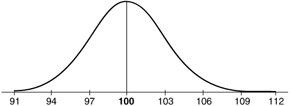MORE SATISFIED THAN AVERAGE?
You calculated a mean satisfaction response of 112 for a sample of 25 customers for product X. This is 12 points higher than 100, which is supposedly the average value for people in general. Is it reasonable to conclude that these customers of product X are different, on average, from people in general? You know that sample means vary, so you do not expect the value observed in a sample to be exactly the same as the population value. And now the question arises: Where did the population come in here? We were just looking at people who purchased product X, right? Yes. In this rather improbable study, the "population" is just the people selected for the study based on the most current information about the purchasers of this particular product. For them, the "population value" of average satisfaction response is the value you would get if you gave a questionnaire to everybody who bought the product and you then calculated the average. The problem with this scenario, however, is that any time you are talking about statistics, the word "population" has a special meaning. It is the people (or animals or things) that you are trying to draw conclusions about. In this study, it is the satisfaction level of all possible customers for this product. In other words, we use samples to predict populations in our simple case. What you have to figure out from your sample of respondents is this: How likely is this sample mean of 112 if the population mean (for everybody who ever bought this product X) is 100?
Use a picture again. Figure 4.6 is the distribution of means for samples of size 25 when the population value is 100 and the standard deviation is 15. It looks a lot like some of the previous diagrams. The difference is that instead of the question mark, you see the value 100, the mean for people in general. You can now locate the observed sample mean on the distribution. It does not fit well, since the value 112 is four standard error units above the mean. This result indicates that it is very unlikely to observe a sample mean as large as 112 in a sample of size 25 when the true population value is 100. Only about 0.006% of the cases in a normal distribution have values as much as four standard deviations away from the mean. So it appears highly unlikely that the customers of product X have the same mean satisfaction response as the general population. On the other hand, if you had observed a mean response of 103 in your sample, you could not say with confidence that the customers were more satisfied than average, since a sample mean of 103 is perfectly reasonable for a population value of 100.

Figure 4.6: The distribution of mean for sample size 25.
EAN: 2147483647
Pages: 252